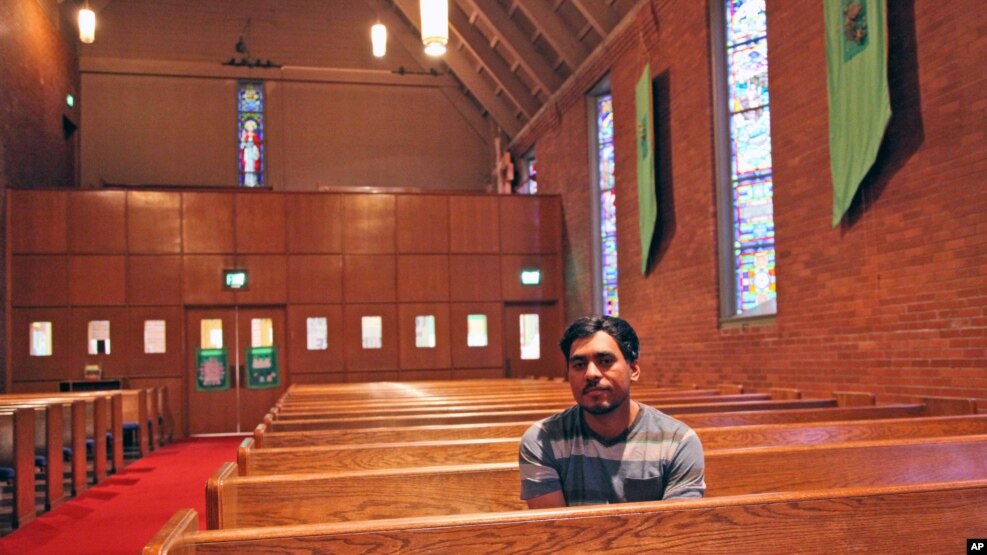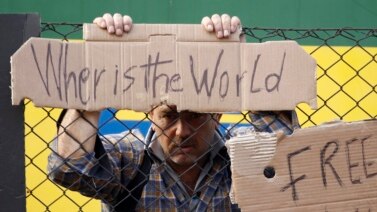
For more than 30 years, religious groups in many parts of the U.S. have provided refuge to immigrants who face possible expulsion from the country.
Today, religious groups are treating non-criminal immigration law violators and their families differently.
The effort to provide refuge for immigrants is called the Sanctuary Movement. It started more than 30 years ago at a time of civil and economic unrest in Guatemala, El Salvador and Nicaragua.
By the end of the 1980s, nearly 1 million refugees had fled north to the United States to seek asylum.
Religious congregations sheltered refugees who would have been denied asylum. They opposed the efforts by the U.S. Immigration and Naturalization Service to deport those people.
In 2014, something similar happened. Violence from the illegal drug trade and gangs, plus weak economic conditions in Central America, led to an increase of refugees and migrants, including children.

Also, an estimated 4.5 million children born in the U.S. have parents who are undocumented. They lack the paperwork required to live as legal residents.
The result has been a policy that has led to more than 350,000 “removals" each year. The term removal means being expelled from the country or denied entry at the border. In many of these cases, family members are separated.
New sanctuary movement considers current policy unfair
A leader of the sanctuary movement 30 years ago was Southside Presbyterian Church in Tucson, Arizona. Recently, the church has restarted its efforts to provide shelter and legal assistance to immigrants facing deportation.
The Reverend Alison Harrington told VOA that a growing number of religious groups feel “outraged and heartbroken” over current U.S. policies. She said these congregations are opening their doors in hopes of keeping families and communities together.
Harrington said individuals and politicians are fueling a growing anti-immigrant nativist movement.
“You kind of have this rising of people, who are people of faith, who will be conscious to say, 'This is not who we believe we are as a people, as an American people,'” Harrington said.
She added that she feels a moral imperative to help.
Southside Presbyterian Church is near the Sonora desert and the U.S. border with Mexico. Harrington said she often meets immigrants seeking assistance.
The 1980s was a period Harrington calls a “nightmare.” She said 80 people slept on the church floor at times, with about 14,000 receiving shelter over a period of 10 years. However, the church now shelters one family at a time, rarely for more than a month.
Harrington said she remembers the case of one family in 2014. A woman named Rosa, her husband and two sons remained at Southside Presbyterian for a record 461 days before Rosa's case was resolved.
“We had to get into high-level negotiations on that one,” Harrington said.
Groups work together to provide services for immigrants
Judson Memorial Church in New York City provides sanctuary in more ways than one.
“It could be physical, it could be spiritual, it could be financial, it could be legal,” the Reverend Donna Schaper said. But the most important term, she said, is “accompaniment.”
“We accompany about 200 people a month, and we train volunteers to go to ICE so they know their rights,” she said. ICE is short for the U.S. Immigration and Customs Enforcement, the agency that deals with immigration issues.
Schaper said that ICE employees are not the enemy. But she said what they do “terrifies people,” and she does not morally respect it.
Miguel Ángel Animas and his two U.S.-born daughters came to the Judson Memorial Church for help. His wife, the girls' mother, was recently deported to Mexico.
Schaper says immigration, like other difficult issues, lacks a human face to inspire quick action or major reform.
“I can't let myself say that [Americans] don't know or that if they knew, they would do something,” she said. “They take care of dogs and cats. These people are not dogs and cats.”
However, Schaper still describes New York City as a “very friendly city” to immigrants. And, during her time at the church, she has seen results, especially at the local level.
The New Sanctuary Coalition of NYC is an alliance of congregations around New York City. In 2009, the coalition started an effort to support immigrants who were found guilty of minor offenses, or whose cases were dismissed. The group sought to prevent ICE agents from questioning and detaining these immigrants at city jails.
The church says that in 2011, the coalition's efforts resulted in then-New York Mayor Michael Bloomberg signing a bill that changed some of those practices.
I'm Mario Ritter.
Ramon Taylor reported this story for VOA News. Mario Ritter adapted it for VOA Learning English. George Grow was the editor.
Words in This Story
congregation - n. people who regularly attend religious services at a church
deport - v. to send out of a country
nativist - adj. related to people whose ancestors lived for a long period in a country and who oppose newcomers or immigrants to it
moral imperative - n. a strongly believed idea or principle that causes a person to act
accompaniment - n. the act of accompanying someone, going with someone to a place
inspire - v. to cause someone to do, believe or feel something


